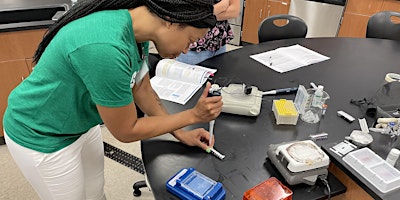Ag Biotech Academy
How can ag biotechnology contribute to food security?
Learn about the latest seed research, perform biology and chemistry labs, hear from industry experts, and get free classroom materials. Ashland graduate credit is available.
Ag Biotech Academy workshops, in partnership with Pioneer, have trained 250+ teachers and contributed over $100K in classroom supplies to Ohio schools.
“If you are wondering if Ag Biotech Academy is for you, the answer is yes! You’ll walk out with information to help your students see the importance of agriculture and its role in our society, and you’ll have a network of individuals to help you succeed in implementing ag-based education in your classroom.”
—first-time attendee Brian Badenhop (read more here)
Ag Biotech Academy introduces teachers to the ways biotech is used in agriculture through food science and biotechnology labs. For teachers of Biology, Chemistry, and Environmental Science. At this two-day workshop all participants will experience:
- Biotech lab skills
- Food science labs
- Biofuels labs
- Industry speakers addressing current trends in the use of biotechnology in agriculture
Each teacher will receive over $300 worth of classroom lab supplies. Hotel and food costs are covered by the Ohio Soybean Council and Pioneer. 18 hours of contact time will be awarded for the 2-day workshop, and 1 hour of graduate credit from Ashland University is available for $180.
Please note: this workshop is geared toward middle and high school teachers. The content covered is above the level of elementary grades science and elementary teachers should not register.
Upcoming Ag Biotech Academy events
Ag Biotech Academy
Standards covered at Ag Biotech Academy
Outcome: 1.3. Business Ethics and Law
- 1.3.2. Follow protocols and practices necessary to maintain a clean, safe and healthy work environment.
Outcome: 1.12. Site and Personal Safety Procedures
- 1.12.7. Select, use, store, maintain and dispose of personal protective equipment (PPE), appropriate to job tasks, conditions and materials.
- 1.12.8. Identify safety hazards and take corrective measures
Outcome: 3.2. Foundations of Chemistry
- 3.2.8. Apply the concepts of stoichiometry and the laws of thermodynamics to chemical reactions.
- 3.2.13. Use and calibrate precision weighing and measuring techniques (e.g., analytical balance, micropipette), based on the metric system.
Outcome: 3.8. Research and Experiments
- 3.8.2. Design a research plan, including the significance of the problem, purpose, variables, hypotheses, objectives, methods of study and a list of materials.
- 3.8.3. Distinguish between dependent, independent and control variables in an experiment.
- 3.8.4. Establish and implement procedures for systematic collection, organization and use of data.
- 3.8.5. Select and apply sampling methods that appropriately represent the population to be studied.
- 3.8.11. Draw conclusions based on observations and data analyses, recognizing that experimental results must be open to the scrutiny of others.
- 3.8.12. Prepare and present findings using scientific reports.
- Strand 3. Biotechnology: Learners apply the skills and knowledge of interpreting laboratory requests, using protective clothing and hazardous material containment, specimen collection procedures, a variety of laboratory testing and techniques, and maintenance of laboratory equipment and supplies.
Outcome: 3.1. Handling, Preparation, Transportation, Storage and Disposal
- Handle, prepare, transport, store and dispose of specimens using procedures that minimize disturbance to the test specimen. Monitor, record and maintain the integrity of equipment and instrumentation, environmental conditions of the facility and the inventory.
Outcome: 3.2. Foundations of Chemistry
- 3.2.5. Write names and formulas for common compounds.
- 3.2.10. Identify materials that can be used as a catalyst.
- 3.2.15. Calculate errors in various measurements, based on data acquired using common laboratory equipment.
Outcome: 3.5. Laboratory Standard Operational Procedures
- Perform methods and techniques using protocols to conduct an experiment.
- Strand 7. Food Science
- Learners apply principles of biology, chemistry and physics to the research, development, production, processing and distribution of food products meeting quality assurance standards in a system that is safe and secure.
Outcome: 1.10. Sales and Marketing
- 1.10.2. Determine the customer's needs and identify solutions.
- 1.10.10. Demonstrate sales techniques.
Outcome: 3.3. Microbiology Testing and Technology
- 3.3.9. Describe molecular behavior and the structure of large molecules, including carbohydrates, lipids, proteins and nucleic acids.

Share this